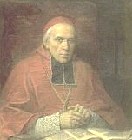

Birth. February 28, 1783, Chapelle, Savoy, now France. From a family of farmers. He was the sixth of the eight children of Jacques Billiet (1739? -1794), rich peasant, originally from Naves-les-Moutiers, and Péronne Peytavin (1744-1814). Received the sacrament of confirmation, 1789. His last name is also listed as Billet.
Education. As a child he carried out pastor duties. He learned to read and write with the priest of his village and from 1798 with an exiled priest, refugee in it, Abbot Péronnier, before entering in 1805 the Grand Seminary of Chambéry. Studied literature, philosophy, physics and theology at the Grand Seminary of Chambéry.
Priesthood. Ordained, May 23, 1807. In the archdiocese of Chambéry, professor and superior of its seminary; canon of its cathedral chapter; vicar general. Founding member and resident of the Società accademica di Savoia, April 23, 1820.
Episcopate. Elected bishop of Saint-Jean de Maurienne, Savoy, December 19, 1825. Consecrated, March 19, 1826, cathedral of Chambéry, by François-Marie Bigex, archbishop of Chambéry, assisted by Claude de Thiollaz, bishop of Annecy, and by Pierre Rey, bishop of Pignerol. Decorated with the Grand cordon of the order of SS. Maurizio e Lazzaro, April 3, 1840. Promoted to the metropolitan see of Chambéry, April 27, 1840. Senator of the Empire, March 4, 1848. President of Académie de Savoie; by acclamation, president perpétuel honoraire. Commendator of the Order of the Legion of Honor of France.
Cardinalate. Created cardinal priest in the consistory of September 27, 1861; received the red hat and the title of Ss. Bonifacio ed Alessio, September 25, 1862.
Death. April 30, 1873, Chambéry. Exposed and buried in the metropolitan cathedral of Chambéry.
Bibliography. "Cardinali defunti." La Gerarchia Cattolica e la Famiglia Pontificia per l'anno 1876. Roma : Tipografia dei Fratelli Monaldi, 1875, p. 134; Chapeau, O.S.B. André and Fernand Combaluzier, C.M. Épiscopologe français des temps modernes, 1592-1973. Paris : Letouzey et Ané, 1974, p. 195-196; Ritzler, Remigium, and Pirminum Sefrin. Hierarchia Catholica Medii et Recentioris Aevi. Volumen VII (1800-1846). Patavii : Typis et Sumptibus Domus Editorialis "Il Messaggero di S. Antonio" apud Basilicam S. Antonii, 1968, pp. 148 and 257; Ritzler, Remigium, and Pirminum Sefrin. Hierarchia Catholica Medii et Recentioris Aevi. Volumen VIII (1846-1903). Patavii : Typis et Sumptibus Domus Editorialis "Il Messaggero di S. Antonio" apud Basilicam S. Antonii, 1979, pp. 15 and 47.
Webgraphy. Biography by Silvio Furlani, in Italian, Dizionario Biografico degli Italiani - Volume 10 (1968), Treccani; photograph and biography, in French, Wikipédia; his portrait and biography, in French, Académie des Sciences Belles-Lettres et Arts de Savoie; biographical data, in French, Senato della Repubblica; his arms, engravings and photograph, Araldica Vaticana.

Birth. May 9 (1), 1808, Montalto. Second child of Giacinto Vincenzo Sacconi (born in 1776) and Carolina Rosati Sacconi. His baptismal name was Carlo Gregorio Polidoro Nicola Giambattista Giacinto Giuseppe Maria Domenico Vito Gabriele.
Education. Studied at the Seminary of Fermo; and at La Sapienza University, Rome, where he earned a doctorate in utroque iure, both canon and civil law.
Priesthood. Ordained (no date found). In the diocese of Montalto, professor in its seminary, 1829; canon of its cathedral chapter; pro-vicar general. Worked in the S.C. of the Tridentine Council for three years. Chamberlain di onore in abito panoazzo, 1832. Auditor in the nunciature in Piedmont, 1839; chargé d'affaires ad interim, January 1844. Chargé d'affaires in Tuscany, 1845-1847. Internuncio in Bavaria, November 13, 1847-1851.
Episcopate. Elected titular archbishop of Nicea, May 27, 1851. Named nuncio in Bavaria, June 6, 1851 (2) to 1853. Consecrated, June 8, 1851, church of Ss. Vincenzo ed Anastasio, Rome, by Cardinal Giacomo Filippo Fransoni assisted by Giuseppe Valerga, Latin patriarch of Jerusalem, and by Rudesindo Salvado Rotea, O.S.B., bishop of Port Victoria. Nuncio in France, October 4 (3), 1853. Assistant at the Pontifical Throne, December 11, 1860.
Cardinalate. Created cardinal priest in the consistory of September 27, 1861; received the red hat and the title of S. Maria del Popolo, September 30, 1861. Commissioned with the erection and organization of the Latin American Seminary, Rome, January 22, 1863. Prefect of the Economy of the S.C. of Propaganda Fide and of the Reverend Chamber of Despoilments, August 29, 1863. Prefect of the Tribunal of the Signature of Justice, December 20, 1867. Protector of the Latin American College at S. Andrea in Quirinale, April 22, 1868. Participated in the First Vatican Council, 1869-1870. Opted for the order of bishops and the suburbicarian see of Palestrina, October 8, 1870. Pro-datary of His Holiness, June 2, 1877; reappointed by Pope Leo XIII, March 5, 1878; occupied the post until his death. Participated in the conclave of 1878, which elected Pope Leo XIII. Opted for the suburbicarian see of Porto e Santa Rufina, July 15, 1878. Opted for the suburbicarian see of Ostia and Velletri, and the deanship of the Sacred College of Cardinals, March 24, 1884. Prefect of the S.C. of Ceremonials, March 28, 1884.
Death. February 25, 1889, at 4:15 p.m., of pleumonite, in the palace of the Apostolic Datary, Rome. The body was transferred to the basilica of Ss. XII Apostoli, Rome, on February 27, 1889 at 11 a.m.; after the absolution, taken to Campo Verano cemetery, Rome; and later, transferred to Montalto and buried in his family's tomb. The funeral took place in that same basilica on March 4, 1889 at 10 a.m.; the mass was celebrated by Félix-Marie de Nekere, titular archbishop of Melitene; the final absolution was imparted by Cardinal Raffaele Monaco La Valletta, bishop of Albano; another twenty-two cardinals were in attendance.
Bibliography. "Cardinali defunti." La Gerarchia Cattolica e la Famiglia Pontificia per l'anno 1903, Città del Vaticano : Tipografia poliglotta vaticana, 1903, p. 186; De Marchi, Giuseppe. Le nunziature apostoliche dal 1800 al 1956. Pref. di Antonio Samoré. Roma : Edizioni di Storia e letteratura, 1957, pp. 55 and 127; L'Osservatore Romano [electronic resource]. Città del Vaticano : L'Osservatore Romano, XXIX, n. 47 (February 26, 1875), p. 3; XXIX, n. 48 (February 27, 1889), p. 2; and XXIX, n. 53 (March 5, 1889), p. 3; Ritzler, Remigium, and Pirminum Sefrin. Hierarchia Catholica Medii et Recentioris Aevi. Volumen VIII (1846-1903). Patavii : Typis et Sumptibus Domus Editorialis "Il Messaggero di S. Antonio" apud Basilicam S. Antonii, 1979, pp. 15, 44, 50 and 411; Weber, Christoph. Kardinäle und Prälaten in den letzten Jahrzehnten des Kirchenstaates : Elite-Rekrutierung, Karriere-Muster u. soziale Zusammensetzung d. kurialen Führungsschicht zur Zeit Pius' IX. (1846-1878). Stuttgart : Hiersemann, 1978. (Päpste und Papsttum; Bd. 13, I-II), II, 514-515, 567, 609, 617, 619, 644, 676, 684, 724, 736, 739, 742, 747, 749 and 756.
Webgraphy. His portrait and biography, in English, Wikipedia; photographs, arms and engravings, Araldica Vaticana.
(1) This is according to all the sources consulted except De Marchi, Le nunziature apostoliche dal 1800 al 1956, p. 55, which says that he was born on May 8, 1808.
(2) This is according to Ritzler, Hierarchia Catholica Medii et Recentioris Aevi, VIII, 411; Weber, Kardinäle und Prälaten in den letzten Jahrzehnten des Kirchenstaates, II, 514, says that he was named on May 27, 1851.
(3) This is according to Ritzler, This is according to Ritzler, Hierarchia Catholica Medii et Recentioris Aevi, VIII, 411; De Marchi, Le nunziature apostoliche dal 1800 al 1956, pp. 55 and 127, says that he was named on September 28, 1853; Weber, Kardinäle und Prälaten in den letzten Jahrzehnten des Kirchenstaates, II, 515, gives the date of his accreditation, December 12, 1853.
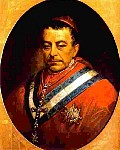
Birth. October 6, 1803, Macotera, diocese of Salamanca, Spain. Son of Francisco García Madrid and Isabel Cuesta Rubio. Baptized, October 9, 1803, parish church of Nuestra Señora del Castillo, Macotera. Received the sacrament of confirmation, July 30, 1814, in the same church. His parents died in 1815 and his uncle, Pablo Cuesta, chaplain of the Shrine of Nuestra Señora de Valdejimena, raised him.
Education. Studied at the Conciliar Seminary of San Carlos, Salamanca, 1818-1828 (humanities, philosophy and theology); and at the University of Salamanca, (bachelor in philosophy, July 20, 1821; bachelor in theology, December 30, 1825; licentiate in theology, September 11, 1828; doctorate in theology, October 11, 1828).
Early life. Substitute professor of mathematics, Conciliar Seminary of Salamanca, 1821. Received the tonsure, minor orders and subdiaconate, May 27, 1825; and the diaconate, February 18, 1826. Professor of Instituciones Filosóficas, University of Salamanca, October 13, 1826. Professor of Greek, University of Salamanca, September 26, 1827. Professor of philosophy, Conciliar Seminary of Salamanca, 1828.
Priesthood. Ordained , March 1, 1828, Salamanca by Agustín Varela y Temes, bishop of Salamanca. In the diocese of Salamanca, 1826-1848, pastoral work; professor of Greek in its seminary, 1830; rector, 1840-1847.
Episcopate. Elected bishop of Jaca, April 14, 1848. Consecrated, Sunday, July 16, 1848, cathedral of Valladolid, by José Antonio Rivadeneyra, bishop of Valladolid, assisted by Carlos Laborda Clau, bishop of Palencia, and by Agustín Lorenzo Varela Temes, bishop of Salmanca. In the same ceremony were consecrated Ignacio Díaz Caneja, bishop of Oviedo, and Joaquín Barbarejo Villar, bishop of León. He was offered the promotion to the archdiocese of Santiago de Cuba but declined it. Promoted to the metropolitan see of Santiago de Compostela, September 5, 1851. Named senator for life of the Kingdom of Spain, by royal decree, October 30, 1851. Named by Queen Isabel II knight with grand cross of the Royal and Distinguished Order of Carlos III, April 20, 1852. Participated in the ceremony of proclamation of the dogma of the Immaculate Conception, Rome, December 8, 1854.
Cardinalate. Created cardinal priest in the consistory of September 27, 1861; received the red hat and the title of S. Prisca, May 21, 1862. Deputy to the constitutional Cortes, 1869. Because of his opposition to the interference of the Spanish government in ecclesiastical affairs, he was denied the passport to attend the First Vatican Council (1869-1870). Elected senator for Vizcaya, April 14, 1872.
Death. April 14, 1873, at 5:30 p.m., in the archiepiscopal palace, Santiago de Compostela. Exposed in the archiepiscopal palace and buried, April 18, 1873, in Capilla del Cristo de Burgos, metropolitan cathedral of Santiago de Compostela.
Bibliography. "Cardinali defunti." La Gerarchia Cattolica e la Famiglia Pontificia per l'anno 1876. Roma : Tipografia dei Fratelli Monaldi, 1875, p. 134; Guitarte Izquierdo, Vidal. Episcopologio Español (1700-1867). Españoles obispos en España, América, Filipinas y otros países. Rome : Instituto Español de Historia Eclesiástica, 1994. (Publicaciones del Instituto Español de Historia Eclesiástica; Subsidia; 29), p. 187; Orive, A. "Garcia Cuesta, Miguel." Diccionario de Historia Eclesiástica de España. Dirigido por Quintín Aldea Vaquero, Tomás Marín Martínez, José Vives Gatell. Madrid : Instituto Enrique Flórez, Consejo Superior de Investigaciones Científicas, 1972-1975. 4 vols., and supplement, 1987, II, 972-973; Ritzler, Remigium, and Pirminum Sefrin. Hierarchia Catholica Medii et Recentioris Aevi. Volumen VIII (1846-1903). Patavii : Typis et Sumptibus Domus Editorialis "Il Messaggero di S. Antonio" apud Basilicam S. Antonii, 1979, pp. 15, 219 and 312.
Webgraphy. Biography by Vicente Cárcel Ortí, in Spanish, Diccionario Biográfico Español, DB~e; his portrait, photographs and biography, in Spanish, Wikipedia; his engraving, signature and biographical data, in Spanish, Senado de España; portraits, engraving and arms, Araldica Vaticana.
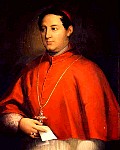
Birth. May 15, 1806, Senigallia. Of a family of modest means. Son of Pellegrino Bedini and Marianna Spadoni. His first name is also listed as Cajetan. Received the sacrament of confirmation, April 29, 1812.
Education. Studied at the Seminary of Senigallia; and at the Archgymnasium of Rome, where he earned a doctorate in utroque iure, both canon and civil law, on June 20, 1837. He spoke French, German, Italian and Portuguese; he had a limited knowledge of English and his secretary had to act as his interpreter during his vist to the United States of America and Canada.
Priesthood. Ordained, December 20, 1828, Senigallia, by Cardinal Fabrizio Sceberas-Testaferrata. Pastoral ministry in Senigallia. Further studies, Rome. Canon of the cathedral chapter of Senigallia, 1829-1838. Secretary to Ludovico Altier, titular archbishop of Efeso, nuncio in Austria, from 1838 to 1845. Internuncio and extraordinary envoy to Brazil, October 28, 1845 to August 16, 1847; at the disposition of the Holy See. Domestic prelate of His Holiness. Protonotary apostolic. Attached to the Secretariat of State, 1848-1849. Named internuncio and extraordinary envoy to Brazil, October 28, 1845; arrived in January 1846; he worked for the betterment of the conditions of the German immigrants and combatted the Protestant proselytism; returned to Rome in March 1848. Substitute of the Secretariat of State, March 10, 1848 to November 1848. Followed Pope Pius IX when he fled to Gaeta because of the revolution in Rome, autumn 1848 to mid-May 1849. Commissary extraordinary to reestablish the papal authority in the Four Legations (Bologna, Ferrara, Forlì and Ravenna) after the fall of the Roman Republic, 1849. Pro-legate in Bologna, 1849; its territory was occupied by Austrian troops and under martial law; during this period, Barnabite monk Ugo Bassi was condemned by a secret military tribunal and executed for treason; the Carbonari and German radicals, who had participated in the Revolution of 1848 and had sought refuge in the United States of America, reproached him, although he had not been informed (1); he accomplished remarkable advances in Bologna reducing unemployment, favoring commerce and agriculture, building roads and restoring public monuments.
Episcopate. Elected titular archbishop of Tebe, March 15, 1852. Nuncio in Brazil, March 18, 1852, but never occupied the post (2). Consecrated, July 4, 1852, church of S. Maria in Portico, Rome, by Cardinal Ludovico Altieri, administrator of Rome and Lazio, assisted by Emmanuel Marongiù-Nurra, archbishop of Cagliari, and by August Karl von Reisach, archbishop of Münich. Assistant at the Pontifical Throne, July 30, 1852. He was charged with making a detour on his way to Brazil and presenting the pope's congratulations to President Franklin Pierce of the United States of America, who had been elected in 1852; his visit lasted from June 30, 1853 to February 4, 1854 (3). He also visited Canada for three weeks (4). Returned to Rome in March 1854 and recommended the establishment of a permanent papal representation in the United States and the foundation in Rome of an American collegio, for the formation of American seminarians. Secretary of the S.C. of Propaganda Fide, June 20 (5), 1856 to 1861. Transferred to the see of Viterbo e Toscanella, with personal title of archbishop, March 18, 1861.
Cardinalate. Created cardinal priest in the consistory of September 27, 1861; received the red hat and the title of S. Maria sopra Minerva, September 30, 1861.
Death. September 6, 1864, Viterbo, of a cerebral congestion. Exposed and buried in the cathedral of Viterbo.
Bibliography. "Cardinali defunti." La Gerarchia Cattolica e la Famiglia Pontificia per l'anno 1876. Roma : Tipografia dei Fratelli Monaldi, 1875, p. 125; Code, Bernard. Dictionary of the American Hierarchy (1789-1964). New York : Joseph F. Wagner, 1964, pp. 12-13; Connelly, James F. ; Bedini, Gaetano. The visit of Archbishop Gaetano Bedini to the United States of America, June 1853-February 1854. Roma : Università Gregoriana, 1960. (Analecta Gregoriana ; v. 109. Series Facultatis Historiae Ecclesiasticae, Sectio B, n.20); Variation: (Analecta Gregoriana ; v. 109). Note: "Part I is historical in character and relates the mission and trip of Archbishop Bedini in the United States and Canada ... Part II is the translation and editing of Bedini's report."; De Marchi, Giuseppe. Le nunziature apostoliche dal 1800 al 1956. Pref. di Antonio Samoré. Roma : Edizioni di Storia e letteratura, 1957, pp. 76-77; Guilday, Peter. "Four early ecclesiastical observers in America." The Ecclesiastical Review, LXXXV (1931), 236-254; Guilday, Peter ; Bedini, Gaetano ; Hughes, John. Gaetano Bedini = An episode in the life of Archbishop John Hughes (1853-1854). New York : United States Catholic Historical Society, 1934. (Historical Records and Studies ; XXIII). Reprinted from Historical Records and Studies, Vol. XXIII, pp. 87-170; LeBlanc, Jean. Dictionnaire biographique des évêques catholiques du Canada. Les diocèses catholiques canadiens des Églises latine et orientales et leurs évêques; repères chronologiques et biographiques, 1658-2002. Ottawa : Wilson & Lafleur, 2002. (Gratianus. Série instruments de recherche), 131-134; McBreen, Eileen Marie. The visit of the Most Reverend Cajetan Bedini to Cincinnati in 1853. Dissertation: Thesis (M.A.)--University of Notre Dame, 1937./ Reproduction: Photocopy./ Notre Dame, Ind. :/ University of Notre Dame Libraries,/ [1988]; Ritzler, Remigium, and Pirminum Sefrin. Hierarchia Catholica Medii et Recentioris Aevi. Volumen VIII (1846-1903). Patavii : Typis et Sumptibus Domus Editorialis "Il Messaggero di S. Antonio" apud Basilicam S. Antonii, 1979, pp. 15, 50, 545 and 593; Weber, Christoph. Kardinäle und Prälaten in den letzten Jahrzehnten des Kirchenstaates : Elite-Rekrutierung, Karriere-Muster u. soziale Zusammensetzung d. kurialen Führungsschicht zur Zeit Pius' IX. (1846-1878). Stuttgart : Hiersemann, 1978. (Päpste und Papsttum; Bd. 13, I-II), II, 437, 556, 610, 616, 618, 643, 657 and 658.
(1) According to LeBlanc, Dictionnaire biographique des évêques catholiques du Canada, p. 231, these groups called him "butcher of Bologna", "Roman hyena" and assassin of martyrs of freedom, and presented him as a danger for the institutions of the republic. In the United States of America he found the hostility of xenophobic, anti-immigration, anti-Irish and anti Catholic movements (such as the Know-Nothing Order); the ethnic infight between Germans and Irishmen; and the current wishing to adapt Catholicism to the republican values with the participation of the laity in the government of the church (Trusteeism) raising the matter of the property of the church's properties.
(2) According to De Marchi, Le nunziature apostoliche dal 1800 al 1956, p. 76, n. 1, he was violently attacked by the liberal Brazilian press for his activity in Romagna during the insurrection of 1848. Because of this, he was recalled to Rome on February 13, 1854, before ever entering Brazil.
(3) He was also asked to survey certain problems concerning the First Plenary Council of Baltimore (May 8 to 19, 1852), particularly the inscription of Catholic children in public schools; and to do an evaluation of the church in the country. He traveled about 3,000 miles and visited the cities of Washington, Baltimore, Philadelphia, New York, Buffalo, Pittsburgh, Chicago, Boston, Detroit, Milwaukee and Louisville. He was constantly attacked by Alessandro Gavazzi, a defrocked Barnabite friend of Bassi; he was almost lynched in Cincinnati in December 1852. He went to Canada at the end of the summer of 1852 and returned from Saint-Hyacinthe to the United States on September 22, 1852. The following October 30, he consecrated in New York the new bishops of Brooklyn, Newark and Burlington. After several death threats, he decided not to travel to the South and left New York secretly at the beginning of February 1853.
(4) He went to Québec and from there, he arrived in Montréal on August 28, 1852. He then visited Bytown, where he received a magnificent reception, and from there, he went to Saint-Hyacinthe, where he was from September 8 to 22, and inaugurated the new seminary. He also visited an Indian village near Montréal. He was impressed by the attachment of Canadians, both Catholics and Protestants, to their religion; by the affection of the Catholics for the Holy See; by the insufficient formation of the clergy; by the conflicts between the French Canadians and the Irish; and by the flourishing of the feminine religious orders. Among the issues that outlined the future were the sending of apostolic delegates; the interference of the clergy in political affairs, attrributed to their lack of formation; and the ethnic and linguistic conflicts that a delegate would be charged with solving.
(5) This is according to Leblanc, Dictionnaire biographique des évêques catholiques du Canada, p. 131; and Ritzler, Hierarchia Catholica Medii et Recentioris Aevi, VIII, 593; De Marchi, Le nunziature apostoliche dal 1800 al 1956, p. 77, says that he was named on June 16, 1856.
Webgraphy. Biography by Peter Condon, in English, The Catholic Encyclopedia; biography by Silvio Furlani, in Italian, Dizionario Biografico degli Italiani - Volume 7 (1970), Treccani; arms and portraits, Araldica Vaticana.
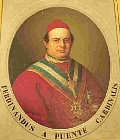 <
<Birth. August 28, 1808, Cádiz, Spain. Eighth child of Bernardo de la Puente y Adaro (1754-1812), a merchant from Maracaibo, originally from Vizcaya, and María Pilar Primo de Rivera y Ortiz de Pinedo (ca.1775-1820?), born in Algeciras. Cousin of Fernando Primo de Rivera (1831-1921), first marquis of Estella (1877).
Education. Studied at Ushaw College, Durham, England; and at the University of Seville, where he obtained a doctorate in theology in 1839.
Priesthood. Ordained, 1832. Professor of theology in the University of Seville for six years. Auditor of the Supreme Tribunal of the Rota in the nunciature in Spain, Madrid, for four years. Curate economous in San Miguel parish, Seville, for six years.
Episcopate. Elected bishop of Salamanca, September 27, 1852. Consecrated, December 19, 1852, church of San Isidro, Madrid, by Giovanni Brunelli, titular archbishop of Tessalonica, nuncio in Spain, assisted by Tomás Iglesias Bácones, patriarch of the West Indies, and by Nicolás Luis Lezo Garro, titular archbishop of Seleucia, abbot of San Ildefonso. Assistant at the Pontifical Throne, January 9, 1855. Promoted to the metropolitan see of Burgos, September 25, 1857.
Cardinalate. Created cardinal priest in the consistory of September 27, 1861; received red hat and the title of S. Maria della Pace, May 21, 1862. Director of the moral and religious formation of the Prince of Asturias, future King Alfonso XII of Spain, 1864-1865 and 1866-1867.
Death. March 12, 1867 at 5:40 a.m., Madrid (1). Transferred by train to Burgos and exposed and buried in the chapel of sanctissimo Christo in the metropolitan cathedral of Burgos.
Bibliography. "Cardinali defunti." La Gerarchia Cattolica e la Famiglia Pontificia per l'anno 1876. Roma : Tipografia dei Fratelli Monaldi, 1875, p. 128; Goñi, J. "Puente y Primo de Rivera," Diccionario de Historia Eclesiástica de España, Dirigido por Quintín Aldea Vaquero, Tomás Marín Martínez, José Vives Gatell. Madrid : Instituto Enrique Flórez, Consejo Superior de Investigaciones Científicas, 1972-1975, Suppl. I, 19-621; Guitarte Izquierdo, Vidal. Episcopologio Español (1700-1867). Españoles obispos en España, América, Filipinas y otros países. Rome : Instituto Español de Historia Eclesiástica, 1994. (Publicaciones del Instituto Español de Historia Eclesiástica; Subsidia; 29), p. 194; Ritzler, Remigium, and Pirminum Sefrin. Hierarchia Catholica Medii et Recentioris Aevi. Volumen VIII (1846-1903). Patavii : Typis et Sumptibus Domus Editorialis "Il Messaggero di S. Antonio" apud Basilicam S. Antonii, 1979, pp. 16, 50, 163 and 491.
Webgraphy. Biography by Vicente Cárcel Ortí, in Sapnish, Diccionario Biográfico Español, DB~e; portraits and arms, Araldica Vaticana; his portrait by José Gutiérrez de la Vega, Universidad de Sevilla, Sevilla, Spain.
(1) This is according to Hierarchia Catholica medii et Recentioris Aevi, VIII, 16 and 50; "Cardinali defunti." La Gerarchia Cattolica e la Famiglia Pontificia per l'anno 1876, p. 128; and Goñi, J. "Puente y Primo de Rivera," Diccionario de Historia Eclesiástica de España, Suppl. I, 619; Guitarte, Episcopologio Español (1700-1867). Rome, 1992, p. 194, indicates that he died on March 20, 1867, and names him Fernando La Puente Primo de Rivera, Universidad de Sevilla, Sevilla, Spain.
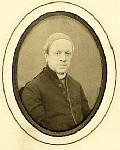
Birth. August 28, 1802, Corneto (now Tarquinia). First child of Count Giacomo Quaglia (1774-1840) and Countess Vittoria Bruschi (1777-1838), from Aspra Sabina. He had a brother, Giuseppe, who was hospitalized for mental illness in the asylum of S. Margherita in Perugia from December 1840 until his death in 1866; and a sister, Maria Giustina, who in 1835 married Count Lucantonio Bruschi-Falgari from whom he had six children, among which Francesco, who was named universal heir of the Quaglia family.
Education. He completed his high school studies in the Sseminary and collegioLa Sapienza University, attending them regularly for only three academic years (1825-1826, 1826-1827 and 1828-1829); he obtained his doctoral degree in utroque iure, both canon and civil law in 1835, with a clear delay.
Priesthood. Ordained, July 16, 1826, in Corneto, by Cardinal Bonaventura Gazola, bishop of Montefiascone e Corneto. Worked in the studio of the S.C. of the Tridentine Council. Referendary prelate, September 5, 1833. Relator of the S.C. of Good Government, 1834-1835. Prelate adjunct of the S.C. of the Tridentine Council, 1835-1841. Voter of the Tribunal of the Apostolic Signature of Justice, 1836-1839. Auditor of the Sacred Roman Rota, August 1839 to 1852. Secretary of the S.C. of the Tridentine Council, March 18, 1852 to 1861.
Cardinalate. Created cardinal priest in the consistory of September 27, 1861; received red hat and the title of Ss. Andrea e Gregorio al Monte Celio, September 30, 1861. Prefect of the S.C. of Bishops and Regulars and of the Discipline of Religious, April 23, 1863 until his death. Participated in the First Vatican Council, 1869-1870. Camerlengo of the Sacred College of Cardinals, 1871 until February 23, 1872.
Death. August 27, 1872, of an apoplexy, in Rome (1). He bequeathed an annual sum for maintaining a shelter for the convalescents who, discharged from the Civic Hospital of his native Corneto, still required assistance. Exposed in the church of S. Maria in Via Lata, Rome, where the funeral took place in the morning of August 30 and buried in the municipal cemetery of Corneto (2). A funeral monument in his memory was erected in the church of Santa Maria Addolorata, in Corneto, designed by Architect Virgilio Vespignani (3).
Bibliography. "Cardinali defunti." La Gerarchia Cattolica e la Famiglia Pontificia per l'anno 1876. Roma : Tipografia dei Fratelli Monaldi, 1875, p. 133; LeBlanc, Jean. Dictionnaire biographique des cardinaux du XIXe siècle : contribution à l'histoire du Sacré Collège sous les pontificats de Pie VII, Léon XII, Pie VIII, Grégoire XVI, Pie IX et Léon XIII, 1800-1903. Montréal : Wilson & Lafleur, 2007. (Collection Gratianus. Série instruments de recherche), p. 770-771; Ritzler, Remigium, and Pirminum Sefrin. Hierarchia Catholica Medii et Recentioris Aevi. Volumen VIII (1846-1903). Patavii : Typis et Sumptibus Domus Editorialis "Il Messaggero di S. Antonio" apud Basilicam S. Antonii, 1979, pp. 16 and 46; Weber, Christoph. Kardinäle und Prälaten in den letzten Jahrzehnten des Kirchenstaates : Elite-Rekrutierung, Karriere-Muster u. soziale Zusammensetzung d. kurialen Führungsschicht zur Zeit Pius' IX. (1846-1878). Stuttgart : Hiersemann, 1978. (Päpste und Papsttum; Bd. 13, I-II), II, 509, 610, 617, 619, 642, 677 and 718.
Webgraphy. Biography by Luca Sandoni, in Italuan, Dizionario Biografico degli Italiani - Volume 85 (2016), Treccani; his arms, portrait, engraving, and photograph, Araldica Vaticana; his sepuchral monument, bottega laziale, secolo XIX (1840), región eclesiástica Lazio, diócesis Civitavecchia-Tarquinia, Bienes Eclesiásticos en web (BeWeB).
(1) This is according to Ritzler, Hierarchia Catholica Medii et Recentioris Aevi, VIII, 16 and 46. "Cardinali defunti." La Gerarchia Cattolica
e la Famiglia Pontificia per l'anno 1876, p. 133; and Weber, Kardinäle und Prälaten in den letzten Jahrzehnten des Kirchenstaates, II, 509, say that
he died on August 28, 1872.
(2) This is according to his biography by Sandoni, in Italian, linked above. "Cardinali defunti." La Gerarchia Cattolica
e la Famiglia Pontificia per l'anno 1876, p. 134; LeBlanc, Jean. Dictionnaire biographique des cardinaux du XIXe siècle, p. 771; and Ritzler,
Hierarchia Catholica Medii et Recentioris Aevi, VIII, 16, n. 42, say that he was buried in his family's tomb in the church of the Servants of Mary, Corneto.
(3) This is the text of the inscription on his funeral monument, kindly provided by Mr. Eman Bonnici, from Malta:
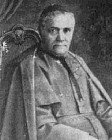
Birth. August 13, 1808 (1), Terranova, diocese of Piazza. Of a noble and rich Sicilian family (2). Son of Count Gaetano Panebianco and Santa Solito. His baptismal name was Niccolò. His first name is also listed as Anton Maria.
Education. Entered the Order of the Friars Minor Conventual (Cordeliers) in 1823 and changed his name to Antonio Maria; professed, 1829; initial studies in Terranova; went to Rome in 1834 to study at Collegio S. Bonaventura; obtained a doctorate in theology in 1836; returned to Terranova.
Priesthood. Ordained (no further information found). Guardian of the convent of Terranovain, 1832. Professor of dogmatic theology in the school of his order in Catania; he also lectured in literature, philosophy and mathematics; and was also professor at the Seminary of Catania. During the political unrest of 1848 in Rome, he was among the several Italians who moved to Malta, during which period he stayed at the convent of the Franciscan Conventual Fathers in Valletta. Socius and general assistant of his order, 1851. Provincial of his order in Sicily, 1853. At the request of Pope Pius IX, traveled to Transylvania together with Archbishop Antonino Saverio De Luca, nuncio in Austria, to solve some problems that arose between the Holy See and the imperial government concerning mixed marriages in that province; the mission, which lasted from September 1 to October 6, 1858, was successful to the satisfaction of both parties. Consultor of the S.C. of the Roman and Universal Inquisition, June 16 (or August 9), 1853. Consultor of the S.C. of Extraordinary Ecclesiastical Affairs, April 28, 1859.
Cardinalate. Created cardinal priest in the consistory of September 27, 1861; received red hat and the title of S. Girolamo degli Schiavoni, September 30, 1861. Following his Franciscan spirit to the end, he refused to have any servants or a carriage after his elevation to the cardinalate, which was customary in those days; and when he was invested in the purple, he put it on over his Conventual habit. Opted for the title of Ss. XII Apostoli, December 23, 1861. Declined the post of camerlengo of the Holy Roman Church and the promotion to a suburbicarian diocese. Prefect of the S.C. of Indulgences and Relics, April 23, 1863. Grand penitentiary, January 17, 1867 to October 15, 1877. Participated in the First Vatican Council, 1869-1870. Camerlengo of the Sacred College of Cardinals, February 23, 1872 until March 21, 1873. Participated in the conclave of 1878, which elected Pope Leo XIII. Secretary of the Supreme S.C. of the Universal and Roman Inquisition, March 30, 1882 to January 25, 1883.
Death. November 21, 1885, at 1 p.m., in his Roman residence in Via di Ripetta n. 102, after a long illness. Exposed in the basilica of Ss. XII Apostoli, where the funeral took place celebrated by Flaviano Simoneschi, titular bishop of Elenopoli in Bitinia, regent of the Apostolic Penitentiary; in attendance were Cardinal Domenico Bartolini, Luigi Serafini, Paul Melchers, Angelo Bianchi, Teodolfo Mertel, Lorenzo Ilarione Randi, Tommaso Zigliara, O.P., Francesco Ricci Paracciani and Ignazio Masotti; as well as the ambassadors of pain and Portugal and other diplomats accredited before the Holy See; Cardinal Carlo Sacconi, dean of the Sacred College of Cardinals, imparted the final absolution. He was buried on December 2, 1885, in Campo Verano cemetery, Rome; at the same time of the burial, a funeral was celebrated by Monsignor Gioacchino Gurrisini, pastor of the mother church of Terranova, natal city of the late cardinal. Three years later, the relatives of the cardinal had a funeral monument erected to his memory in one of the lateral naves of the mother church of Terranova (3).
Bibliography. "Cardinali defunti." La Gerarchia Cattolica e la Famiglia Pontificia per l'anno 1903, Città del Vaticano : Tipografia poliglotta vaticana, 1903, p.182; Montini, Renzo U. "Panebianco, Antonio Maria." La Enciclopedia Cattolica, 12 vols. Città del Vaticano: Ente per l'Enciclopedia Cattolica e per il Libro Cattolico, 1949-1954, IX, col. 675-676; L'Osservatore Romano [electronic resource]. Città del Vaticano : L'Osservatore Romano, XXV, n. 267 (November 22, 1885), p. 3; XXV, n. 268 (November 24, 1885); and XXV, n. 269 (November 25, 1885), p. 3; Ritzler, Remigius. "I cardinali e i papi dei Frati Minori Conventuali," Miscellanea Francescana, LXXI (1971), 69-70; Ritzler, Remigium, and Pirminum Sefrin. Hierarchia Catholica Medii et Recentioris Aevi. Volumen VIII (1846-1903). Patavii : Typis et Sumptibus Domus Editorialis "Il Messaggero di S. Antonio" apud Basilicam S. Antonii, 1979, pp. 16, 46 and 48; Weber, Christoph. Kardinäle und Prälaten in den letzten Jahrzehnten des Kirchenstaates : Elite-Rekrutierung, Karriere-Muster u. soziale Zusammensetzung d. kurialen Führungsschicht zur Zeit Pius' IX. (1846-1878). Stuttgart : Hiersemann, 1978. (Päpste und Papsttum; Bd. 13, I-II), II, 498-499, 611, 617, 619, 622, 642, 663, 680, 687, 717, 719, 740, 747, 751 and 758.
Webgraphy. Photograph monument and biography, in Italian, gelacittadimare.it; his engraving, photographs and arms, Araldica Vaticana; The Panebianco surname and arms, panebianco.org.
(1) This is according to all the printed sources in the bibliography; his biography in Italian, linked above, says that he was born on August 13, 1805, which is probably a typographical error because that source says that he died in 1885 at 77.
(2) This is according to Weber, Kardinäle und Prälaten in den letzten Jahrzehnten des Kirchenstaates, II, 498, citing "Tableau des cardinaux" of Baron von Bach; and "Tableau des cardinaux" by Francesco Lasagni; F. Galvani, also cited by Weber, II 498, says that he was of umili, ma onestissimi genitori (humble but most honest parents).
(3) This is the text of the inscription on the monument, kindly provided by Mr. Eman Bonnici, from Malta:
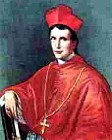
Birth. August 3, 1800, Milan. Second of the two sons of Giuseppe Ramazzotti and Giulia Maderna. The parents were both from Saronno; they got married at a rather mature age: his father was 41 years old and his mother 39. The elder brother, Filippo, was born one year before him. Received the sacrament of confirmation, October 1806; insignias of the clerical character, September 23, 1826; minor orders, December 22, 1826 and December 21, 1827; subdiaconate, March 14, 1829; diaconate, April 4, 1829.
Education. Studied at the University of Pavia, where he obtained a doctorate in utroque iuris, both canon and civil law, on August 10, 1823; and at the Seminary of Milan.
Early life. For three years practiced law in Milan; entered the seminary in 1826.
Priesthood. Ordained, June 13, 1829. Joined the Missionary Oblates of Rho, on the same day of his ordination; three times rector of their school; missionary work and preacher in Milan and Como for twenty years.
Episcopate. Elected bishop of Pavia, May 20, 1850. Consecrated, June 30, 1850, church of S. Carlo al Corso, Rome, by Cardinal Giacomo Filippo Fransoni, assisted by Giuseppe Valerga, Latin patriarch of Jerusalem, and by Giovanni Domenico Stefanelli, O.P., titular archbishop of Traianopoli di Rodope. Founder of the Lombard Seminary for the Pontifical Institute for Foreign Missions (PIME); it officially opened July 30, 1850. Promoted to the patriarchal see of Venice, March 15, 1858. Assistant at the Pontifical Throne, March 2, 1860.
Cardinalate. On August 22, 1861 official news that he was going to be created cardinal in the consistory of September 27, 1861 was sent to him but he died three days before its celebration. He wrote Pope Pius IX trying to dissuade the pope because of his poor health (suffering from angina pectoris) and to Cardinal Giacomo Antonelli because of his precarious financial condition and the expenses involved in receiving the purple.
Death. September 24, 1861, Gherla di Crespano del Grappa, where he had gone to recover his strength. Exposed in the patriarchal cathedral of Venice, where the solemn funeral took place celebrated by Bishop Antonio Farina of Vicenza, future blessed. Canon Antonio Ciconi delivered an emotional tribute in his eulogy at the end of the mass. Buried in that patriarchal cathedral. Transferred to the church San Francesco Saverio, annexed to the mother house of the Pontifical Institute for Foreign Missions (PIME), Milan, 1957 (1). Cardinal Angelo Roncalli, patriarch of Venice, and Giovanni Battista Montini, archbishop of Milan, two future popes, participated in the ceremony.
Beatification. The canonical process of beatification was opened in 1978. Its different stages have taken place in 1987, 1998 and 1999.
Bibliography. Niero, Antonio. I patriarchi di Venezia. Da Lorenzo Giustiniani ai nostri gironi. Venice : Studium Cattolico Veneziano, 1961, pp. 184-188; Ritzler, Remigium, and Pirminum Sefrin. Hierarchia Catholica Medii et Recentioris Aevi. Volumen VIII (1846-1903). Patavii : Typis et Sumptibus Domus Editorialis "Il Messaggero di S. Antonio" apud Basilicam S. Antonii, 1979, pp. 439 and 584.
Webgraphy. Portraits and biographical data, in Italian.
(1) This is the text of the inscription on his tomb, kindly provided by Mr. Eman Bonnici, from Malta:
This is the text of another plaque placed in 1958 on the 97th anniversary of his death, also kindly provided by Mr. Eman Bonnici, from Malta:
QUI RIPOSANO LE OSSA E LE CENERI DI
ANGELO RAMAZZOTTI
PRIMA VESCOVO DI PAVIA
POI PATRIARCA DI VENEZIA
A MEMORIA DI LUI, LORO AMATISSIMO PADRE
E A TESTIMONIANZA DELLA SUA ECCELSA VIRTU’
AFFINCHE’ RIMANESSE NEI SECOLI
QUELLA FONDAZIONE
CHQ QUANDO ERA ANCORA SACERDOTE
OBLATO DI RHO
CON FELICE AUDACIA AVEVA VOLUTO
PER FORMARE ARALDI DEL VANGELO DI CRISTO †
A.D. 1958 - 97° DALLA MORTE
IL 3 MARZO 1958
ANGELO GIUSEPPE RONCALLI
PATRIARCA DI VENEZIA
POI ELETTO PAPA CON IL NOME DI
GIOVANNI XXIII
CON GRANDE AFFETTO DONO’ AI FIGLI
QUESTE SACRE RELIQUIE
DEL LORO PADRE
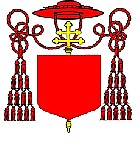
Birth. November 6, 1789, Città di Cento, archdiocese of Bologna. Of a family from the patriciate of Bologna that was attached to the service of the Roman Curia. Son of Francesco Alberghini and Clara Comi. Brother of Cardinal Giuseppe Alberghini (1834).
Education. Studied law (no further educational information found).
Early life. Aiutante di studio of Costantino Patrizi, auditor of the Sacred Roman Rota and future cardinal (1823-1829). Conclavist of Cardinal Pietro Gravina in 1823. By papal bull of February 25, 1836, Pope Gregory XVI named him auditor for Bologna of the Tribunal of the Sacred Roman Rota; admitted to the tribunal on February 29th; took the oath on November 18th; entered in functions on November 25, 1836. Promoted domestic prelate of His Holiness before March 2, 1836. Named member of the Council of State, constituted by Pope Pius IX, on May 13, 1848; he resigned the post the following June 17th. On November 6, 1848, he was named member of the commission for the reform of civil and criminal procedures. After the papal restoration of 1849, he became a member of the S.C. of Rites. Consultor of the S.C. of the Holy Office before March 2, 1858. Dean of the Sacred Roman Rota, March 15, 1858.
Sacred orders. (No information found).
Cardinalate. According to Boutry, Souverain et Pontife, he declined the promotion to the cardinalate offered by Pope Pius IX. After having declined the promotion, was named emeritus by the pope on September 16, 1861.
Death. January 30, 1869, Rome. Buried in Gesù church (1), Rome, where his brother is also buried.
Bibliography. Boutry, Philippe. Souverain et Pontife : recherches prosopographiques sur la curie romaine à l'âge de la restauration, 1814-1846. Rome : École française de Rome, 2002, p. 490.
Webgraphy. Biography, in German, Wikipedia.
(1) This is the text of the inscription on his funeral monument in the Gesù church, kindly provided by Mr. Eman Bonnici, from Malta:
SACRI CIVILISQUE IURIS CONSULTISSIMO
SENIORI XV VIR LIT IUDICANDIS CONSILIARIO A PUBLICIS NEGOTIIS
QUI INTER PRAEPOS CODICI LEGUM POENALIUM ORDINANDO
ET QUAESTIONIBUS MODERANDIS
ITEMQ IN SACRUM CONSIL ECCLESIAE IURIBUS RETINENDIS ADLECTUS
OB PRAESTITAM IN HIS ALIISQUE MUNERIBUS VIRTUTEM ET PRUDENTIAM
A PIO IX P M PATER CARD DESIGNATUS OBLATUM ONOREM MODESTE DETRECTAVIT
SOLATOR EGENORUM SIBI PARCUS AMICUS CERTUS DEQUE RELIGIOSIS VIRIS
PER ADVERSA TEMPORA OPTIME MERITUS VIXIT ANNOS LXXVII
DECESSIT III KAL FEBRUAR A MDCCCLXIX
| Top | Catalogs | Home |
©1998-2022 Salvador Miranda.